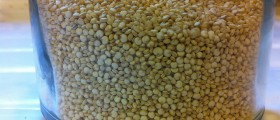
Legumes in the Diet
Legumes are members of large Leguminosae vegetables family that is characterized by seeds located in the two halves of green cover. This group of foods includes: beans, soy, broad beans, peas, lentils, alfalfa, and peanuts. Many people make a mistake when they think that peanut is one of the nuts. The only difference, compared to other legumes, is that the peanut’s pod will not open by itself, but it must be forcefully peeled after drying. And another thing, the peanut is the only legume edible immediately after drying while the other must first be thermally processedUnlike other vegetables, legumes have the ability to bind nitrogen from the air (using nitric bacteria in the root) to create high-quality protein with essential amino acids. Because of the quality protein content, legumes are possible meat substitute which significantly contribute to a healthy diet. It is said that legumes are at the bottom of the desirable foods chart, and until recently some of them belonged to the category of animal food (soybean). Such a wrong perception is largely caused by forming a gas in the colon during digestion of legumes (decomposition of polysaccharides under the influence of the microflora), which is certainly unpleasant side effect.
The following facts should be noted: Legumes are the best and the largest source of vegetable protein in the diet, and, satisfactory biological value of amino acids can be achieved by their combination with grains. In addition, legumes are, with the exception of soybean and peanut, low fat foods with low calorie content.It should be noted that fat contained in legumes consists of monounsaturated and polyunsaturated fatty acids that are much better for the body than saturated fatty acids from fats of animal origin. Use of legumes in the daily diet definitely changes fat level in the blood and lowers cholesterol levels.
Nutritional Composition of Legumes
Legumes are foods with a low glycemic index which means that they provoke little or no insulin secretion in the pancreas, because they mostly contain complex carbohydrates that are very slowly converted into glucose.Legumes are gluten-free foods which can be successfully used in the treatment of gluten enteropathy.
When it comes to legumes, their content of soluble and insoluble fibers is what is usually completely forgotten. Namely, the so called seventh component of food (fiber structure) is important for digestion and metabolism, as well as all the other components. Fibers retain water, collect the toxins, increase the volume of intestinal content, prevent constipation and reduce the risk of colon cancer and other diseases (Diverticulosis). Modern food from the supermarket is short in the supply of fibrous structure so the consumption of legumes, especially beans, is the best solution.
Some legumes, such as soy, contain an abundance of phytoestrogens. Given that plant estrogens have a similar structure with the native hormones, they can somewhat emulate their actions in the body and thus have a beneficial effect on menopausal symptoms and preventive effect on prostate cancer and breast cancer.
As for the minerals and vitamins, the content of iron, calcium and magnesium must be emphasized. Then there are the inevitable B-complex vitamins, particularly folic acid. For example, 100 g of raw soybean contains about 15 mg iron, 277 mg calcium and 280 mg magnesium. The valuable content of 5 mg of zinc and 18 mg of selenium also should be mentioned.
















Your thoughts on this
Loading...